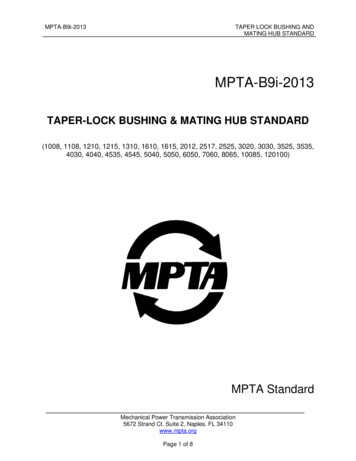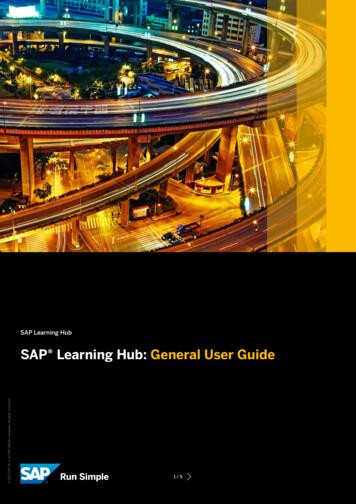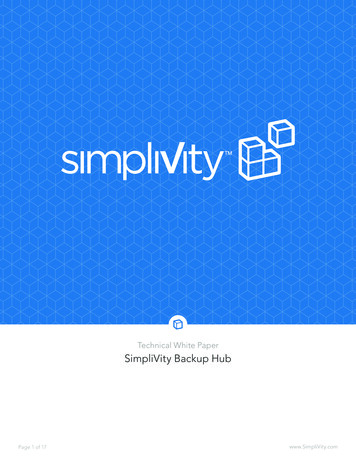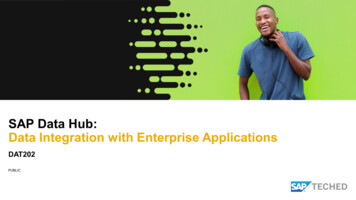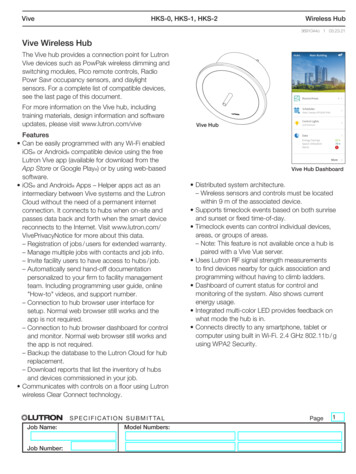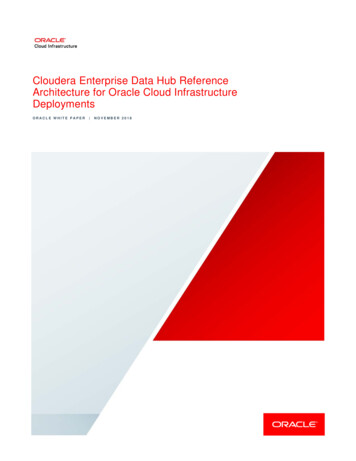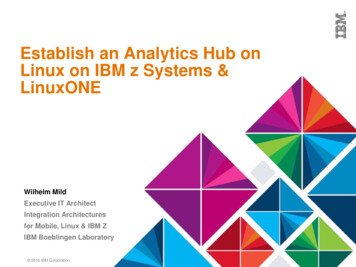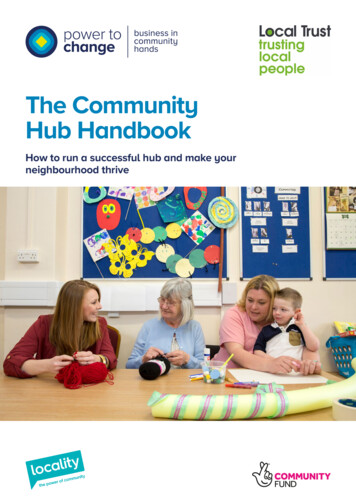
Transcription
The CommunityHub HandbookHow to run a successful hub and make yourneighbourhood thrive
Power to ChangePower to Change is theindependent charitable trustthat supports and developscommunity businesses inEngland. Endowed with 150million from the National LotteryCommunity Fund, we workto revive local buildings andspaces, protect the servicespeople rely on, and addresslocal needs. Since 2015 we haveinvested nearly 18 million incommunity hubs.www.powertochange.org.uk@peoplesbizLocal TrustLocal Trust was establishedin 2012 to deliver Big Local, aunique programme that putsresidents across the country incontrol of decisions about theirown lives and neighbourhoods.Funded by a 200m endowmentfrom the National LotteryCommunity Fund – the largestever single commitment oflottery funds. Big Local providesin excess of 1m of long-termfunding over 10-15 years to eachof 150 local communities, manyof which face major social andeconomic challenges but havemissed out on statutory andlottery funding in the past.LocalityLocality is the nationalmembership network supportinglocal community organisationsto be strong and successful.By pooling knowledge,understanding and tools we builda better understanding of whatworks. Together we motivate andinspire each other to unlock thepower of local caltrust.org.uk@localtrustThe Community Hub Handbook: Everything you need to know about running a successful hub to makeyour neighbourhood thrive was researched and written by Locality and funded by Local Trust and Power toChange in January 2020.Power to Change Trust is registered in England, charity number 1159982. powertochange.org.ukThis work is licensed under the Creative Commons Attribution-NonCommercial-ShareAlike 4.0 InternationalLicense. To view a copy of this license, visit Front Cover imagePhotographer: Andrew Aitchison/Local Trust.Natalie, Edna and Naomi chat at a Knit & Natter group in Harefield Hub, run by SO18 Big Local in Southampton.Published January 20202The Community Hub Handbook
ContentsINTRODUCTION4STEP 1. UNDERSTANDING COMMUNITY HUBS61.16What is a community hub?STEP 2. GETTING STARTED92.1 Understanding what your community needs92.2 Building a positive and effective team152.3 Having a positive culture – involving lots of people from across the community,being accountable and embracing change182.4 Providing services local people value and which can be paid for212.5 Building positive relationships with others26STEP 3. ACQUIRING COMMUNITY HUB PREMISES323.1 Ensuring that the building is an asset, rather than a liability323.2 Building or improving community hubs36STEP 4. MANAGING THE PREMISES AND YOUR ORGANISATION414.1 Managing an attractive, welcoming and well used building414.2 Running a tight financial ship544.3 Having effective structures and processes584.4 Reviewing what you do and understanding the impact you are having in your area62RESOURCES AND LINKS66Balanced Scorecard guidance and template66Capital project – cashflow template69Revenue project – cashflow template74Examples of some community hub build costs and annual running costs84EXTERNAL LINKS87GLOSSARY94The Community Hub Handbook3
IntroductionOpening a community hub is no small achievement and keeping it openand active is harder still. People who succeed at it are canny folk – theyshow grit, ingenuity and determination. Yet they’ll often talk about howmuch more they wish they had known at the outset – mistakes they latersee were avoidable.That’s one reason why we’ve created TheCommunity Hub Handbook – to fill a gap inpractical guidance, help people avoid commonpitfalls and ensure those running community hubshave access to the best information available.We commissioned Locality to write this handbook,based on their knowledge of supporting communityhubs, and on a report that Local Trust and Power toChange commissioned in 2019 “Community Hubs:understanding survival and success”. This researchis referenced throughout this handbook andhas additional case studies you can draw on forinspiration. Unlike community centres and similarbuildings, hubs are multi-purpose. Perhaps thisis why there’s so little information specifically forthem, and even less that addresses their financialviability.Spreading the knowledge and tools to helpcommunity hubs survive and thrive is much needed,and not just by those ‘do-ers’ who typically getinvolved in running community spaces. Local,accessible meeting places directly benefit peopleliving nearby, and it’s increasingly recognised thatthey matter nationally too.A welcoming venue packed with positive, nurturingand inclusive activities fosters social capital – avital ingredient in every local economy. Whenpeople have a place to meet, they can build trust,share concerns and identify solutions that maydevelop into successful projects, local servicesor social enterprises. If a community business is apossibility in your area, Power to Change’s websiteis packed with inspiration and support, includingfunding for start-ups and bright ideas, so do find outwhat’s on offer.4The Community Hub HandbookWhere hubs are also community led or owned,they have the potential to alter the self-belief andambition of local residents too. Across 150 Big Localareas, there are multiple examples of communitieshatching imaginative resident-led schemes: selffinancing housing projects, sustainable energydevelopments, and transformations of greenspaces and sports grounds are a few examples.Many more can be found on Local Trust’s website.Resident-led projects build resilience, energise civiclife and change individuals driven by passion intocommunity leaders with the skills and experienceto transform their neighbourhoods.So, that moment when the ribbon is cut anda community hub is declared open is rich inpossibilities. Beyond a vision of dance practice,digital skills, crafts, parenting or cooking classesthere’s a real and meaningful opportunity to bringneighbours together, revive community spirit andimprove lives. Creating fun activities is somethingthat communities excel at – no advice is neededthere. But for business essentials – managingbuildings, securing income, attracting bookings anddemonstrating impact – this Handbook can help.It is packed with tried-and-tested tools andessential, hard-won knowledge to inform yourplans and decisions. Explore it, test it, try it andshare it. We’d love to hear what happens next.
Each section provides information and links tocase studies to inspire anyone contemplatingstarting up or delivering a community hub. Atthe end of each sub-section there is a checklistto answer for yourself – answer the questions tofigure out your progress and where you may needto focus. Business planning and financial toolsand templates and links to online resources areprovided in the Resources and links section. Wheretechnical terms have been used in the toolkit, theyare highlighted and explained in the Glossary.Where financial data has been provided it is forguidance purposes only, do not assume that yoursituation will be the same. Get your own quotesbased on the advice provided.Acknowledgements:Community ownership and management of landand buildings is not new. The information andguidance contained in this toolkit reflects theexperience of many people who have gone throughthe process. We would like to thank the followingpeople who gave their time and knowledge to thedevelopment of this toolkit:Steve Wyler, Lorraine Hart, Ian Smith, Edith Lang,Bill Badham, Alison Jones, Mary Green, MairiRadcliffe, Julian Mellor, and Maddy Pritchard.You may choose to read the sections that aremost relevant to you or work your way througheverything, but don’t be daunted by it all, take onestep at a time. In practice, you will probably need todo several things at once (and repeat some of thesame steps) depending on your starting point andyour objectives. Community hubs are rarely smoothand easy to establish, you often go backwards andforwards through the different stages until you areready to move on again.The most successful community hubs arecollaborative efforts, where many people in thecommunity are involved. We encourage you touse this toolkit is a similar way; involve as manypeople as possible in your conversation to buildup a rounded understanding of the context andpracticalities for your community hub.The Community Hub Handbook5
Step 1. Understanding Community HubsStep 1. Understanding community hubs1.1 What is a community hub?Community hubs are an incredibly diverse groupof entities, ranging from communal garden sheds tomultipurpose community centres. Community hubsare buildings (or parts of buildings). They provideand host community activities that local peopleneed. They are led and run by the community andare open and accessible to everyone. This alsomeans their purpose can change over time to beavailable to people.The services provided in community hubs are verydiverse – this is a strength and sets them apartfrom other businesses which tend to do one thing.These include activities that directly addresscommunity needs and help community memberslive happy, healthy and economically thriving lives.They may also provide opportunities for communityengagement and a focal point for people to meet.Community hubs are funded in many ways, oftenincluding an element of grant funding. However, themost successful and sustainable community hubsalways have an element of enterprise; they earnmoney from their activities that is put back into therunning of the hub for the benefit of the community.Community hubs are often set up and run toprovide one or more of the following:–Facilities for the use of the local communityto ensure a healthy, active and economicallythriving population.–Services for the local community, directlyor indirectly.–Opportunities for community engagement,volunteering, the empowerment of localpeople.–The ‘added value’ of a thriving community hubwhich enhances community life, e.g. providinga focal point for local people, providing a senseof community, providing spaces for people tomeet, etc.Community hubs may offer:–Meeting rooms.–IT facilities.–Community cafés.Community hubs are very diverse. This reflectsthe fact they usually arise from local peopleworking in very different areas and addressing verydifferent local needs. While every community hub isdifferent, most community hubs:–Offices and training rooms.–Sports and arts facilities.–Play areas.–Focus on a clearly defined local area andcommunity.–Nursery facilities.–Deliver a wide range of services to the localcommunity that meet community needs. Thediversity of community hubs stems from thefact that they meet a wide range of communityneeds identified locally.–Older people activities.–Games and youth facilities.–Conference facilities.–Kitchens and catering facilities and much more.Common features of a community hub–6What do community hubs provide?Operate from one or more buildings – althoughthe concept of a building may be loose – it maybe bricks and mortar or a shed, or open space.The Community Hub Handbook
Step 1. Understanding Community HubsAccording to research1 the most common primaryactivities carried out by community hubs are:Community hall ormeeting space (59%)Health or well-beingactivities (17%)Educationalactivities (13%)Skills and employmenttraining (12%)–Micro organisations (turnover less than 100,000). These tend to be heavily reliant ongrants and donations, and to a smaller extenton income generated from the building, suchas hall hire. Other types of trading income arelikely to be at a low level.–Small organisations (turnover 100,000 to 250,000). These are also usually reliant ongrants and donations but are likely to haveincreased their building income. Other tradingincome may also have increased but as arule this still tends to be at a low level, as aproportion of overall income.–Medium organisations (turnover 250,000 to 750,000). Grants and donations and buildingincome generally remain the most significantrevenue streams, but trading income, includingsocial enterprise activities and fees andsales, is likely to have increased, and theorganisation may also be generating someincome from service contracts.–Larger organisations (turnover more than 750,000). The main source of income islikely to be from service contracts, with lowerproportions from grants and donations orhall hire, office rentals, or other forms oftrading income.Community café (11%)While many people have a vision for a communityhub that may approach something like a traditionalcommunity centre, there are other models. Theseinclude offering services from a shed on anallotment, from a local shop, a GP surgery, apub, etc.Some community hubs start with a space fromwhich they design a service offer and others startfrom another space with a specific purpose, fromwhich they develop a suite of services on offer tothe community over time.How are community hubs funded?Community hubs are funded in different ways.They are often supported by grants, but many areincreasingly striving to generate earned incomeand be more independent and sustainable.Research1 shows community hubs that have bestadapted to reduced grant funding, run spaces thatthey can generate income from, including rentingspace and hosting services. Furthermore,it suggests (see: 3.3 Business models of communityhub organisations in the research1) that there arefour types of community hubs based on sizeof turnover:1The most sustainable community hubs have a mixof income with some services subsidising others.Part of their income mix may be generated byrenting out offices, rooms for regular meetings,conferences and events. Charges are usually ona sliding scale, so that a large and well-fundedcustomer such as a local authority or privatebusiness pays a higher charge than small,unfunded community hirers such as self-help andadvocacy groups.Community hubs are special because there areso many
Step 1. Understanding Community Hubs The Community Hub Handbook According to research 1 the most common primary activities carried out by community hubs are: While many people have a vision for a community hub that may approach something like a traditional community centre, there are other models. These include offering services from a shed on an allotment, from a local shop, a GP surgery,
